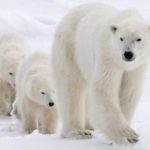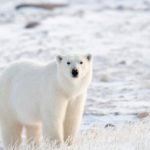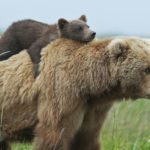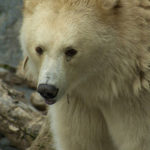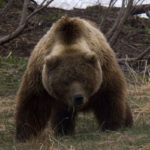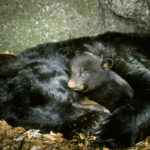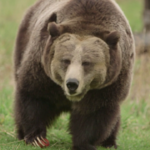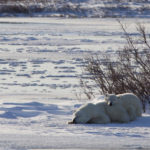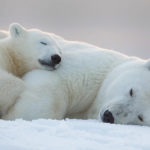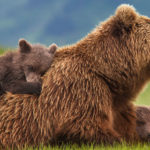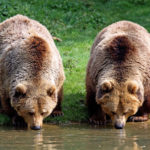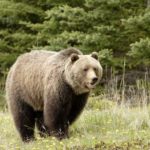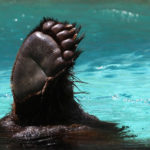Polar bears
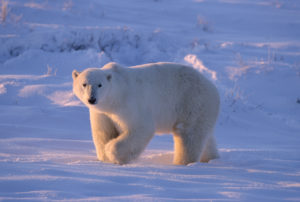 The polar bear is a predatory mammal from the bear family. Until now it was believed that modern polar bears descended from brown bears. Using the analysis of mitochondrial DNA, it was established that the ancestor of polar bears, the so-called “mitochondrial Eva”, inhabited the territory of modern Ireland about 45 thousand years ago.
The polar bear is a predatory mammal from the bear family. Until now it was believed that modern polar bears descended from brown bears. Using the analysis of mitochondrial DNA, it was established that the ancestor of polar bears, the so-called “mitochondrial Eva”, inhabited the territory of modern Ireland about 45 thousand years ago.
Currently, white and brown bears can interbreed and give offspring, although they are considered different species. However, the question of the origin of polar bears can not be considered definitively resolved, scientists believe. Recent studies of mitochondrial DNA of various species of bears have shown that all living polar bears originate from one population of brown bears that existed about 120,000 years ago in Alaska.
Taking into account the imperfection of the method of research, dating raises some doubts. The newest research shows a new study gives new estimates of the age of polar bears as an independent species that is about 600 thousand years old.
The polar bear is the largest predator inhabiting the land. The weight of an adult male reaches 700 kg, and the length reaches 3 m. A white bear from other bears is distinguished by a long neck, a flat head and powerful sloping shoulders. The head of a polar bear is elongated, flat on top and relatively narrow. The forehead is flat. The wide muzzle in front is sharpened. Ears short on top rounded. The nostrils are wide open.
The skull of a polar bear is longer than a brown one. The mouth of the mouth is not as deeply cut as the brown bear. The tail is very short, thick and dull, barely visible from under the coat. There are no eyelashes on the eyelids. With the exception of a dark ring around the eyes, a bare nose, lip edges and claws, the polar bear is covered with thick fur. His skin is black. The color of the coat varies from white to yellowish. Summer fur can turn yellow due to the constant exposure to sunlight. The dense and thick coat of a polar bear is devoid of pigmentation. It perfectly keeps the heat. This is due to the special structure of the wool. Inside, they are hollow and perfectly pass the ultraviolet rays, which give the wool the property of retaining heat.
Another protection against frost and piercing northern winds is a 10-centimeter layer of subcutaneous fat. The soles of the legs of a polar bear are lined with wool, so as not to slide over the ice and do not freeze. For a quick and comfortable swim, a small swimming membrane is located between the fingers. Curved, thick claws can even hold strong prey. Broad feet allow the animal to move without difficulty in deep snow.
The polar bear lives in the Arctic, only sometimes it can be found in the mainland tundra. This is the largest representative of not only the family, but the entire order of predators. Despite its size and apparent slowness, polar bears even on land are quick and dexterous, but in the water they swim easily and far, freely dive. The polar bear, by its enormous strength, size and versatility of predatory abilities, can rightly be called the king of the Arctic Ocean. He has an unusually keen sense of feeling, and during attacks shows an astonishing cunning. Scientists believe that polar bears are close in intelligence to monkeys.
Without good mental abilities, hunting and survival under polar conditions would be impossible. Polar bears make seasonal roosts in accordance with the annual changes in the polar ice border. In the summer, bears go along with the ice closer to the pole, in winter moves to the south, going to the mainland. Although the polar bear rests mainly on the coast and ice, in winter it can lie in a den on the mainland or on islands, sometimes 50 km from the sea. In winter hibernation, lasting 50-80 days, there are mainly pregnant females. Males and single females go into hibernation for a short time and not annually.
Polar bears are obsessed with cleanliness. It is noticed that bears eat usually 20-30 minutes and then they are sent to wash in the water in the summer or use snow to clean the wool in winter. Approximately 15 minutes takes this ritual, which allows you to keep the wool clean. The presence of dirt or moisture in the wool worsen its heat-insulating properties. After swimming, polar bears are very carefully wiped out, rolling in the snow. Bears know how to take snow with their front paws and wipe them off like a towel.
Their prey polar bears either wait patiently, or are caught unawares. The favorite prey of polar bears is ringed seal, walrus, sea hare and fish. White coloring contributes to the disguise of a predator when he lies in wait for prey. They do not disdain the bird eggs, seaweed and food remnants that are found near human habitation.

